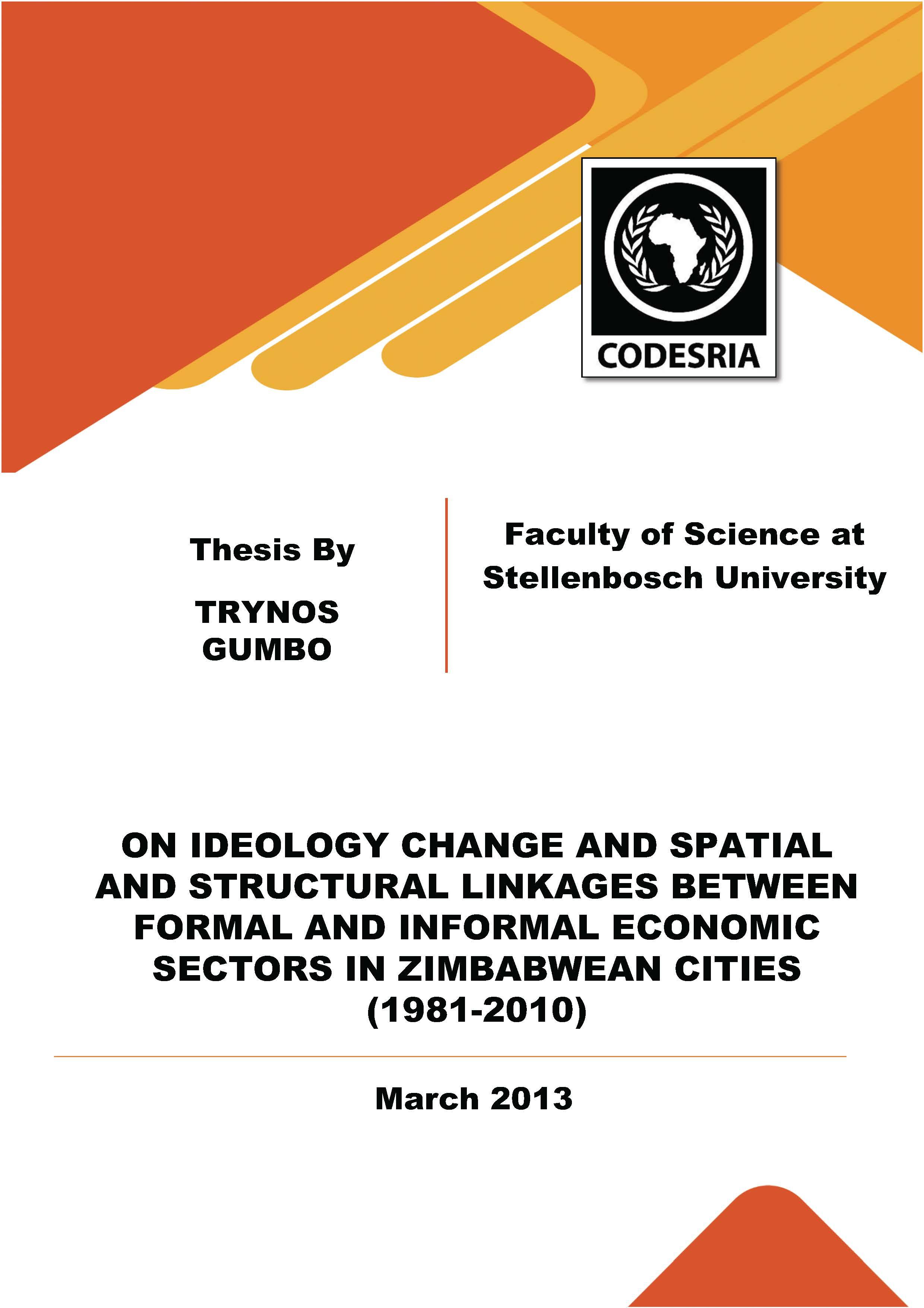On Ideology Change and Spatial and Structural Linkages between Formal and Informal Economic Sectors in Zimbabwean Cities, 1981-2010
Keywords:
Economic systems, ideologies, geographic information systems, spatial analysis, urban areas, formal sector, informal sector, capitalism, socialism, ZimbabweSynopsis
Zimbabwean cities have been experiencing wide-ranging economic restructuring since independence in 1980. The relationships between the declining formal economy and the growing informal economy concomitant with political and economic ideological shifts over the years have not been studied extensively and are not well understood. In this study the impact of political and economic ideological shifts on the growth, spatial and structural linkages between the two sectors over the three decades, from 1981-2010, in the country’s two main cities, Harare and Bulawayo, is investigated. Mixed-method approaches were applied to gather spatial, quantitative and qualitative data. Geospatial data were created using 1164 and 857 geographical positioning system locational points of informal economic enterprises in Harare and Bulawayo respectively. Maps of the two cities were scanned, georeferenced, projected and digitised. Longitudinal and crosssectional data were gathered from archival sources and through 300 and 600 questionnaire surveys of formal and informal economic operators respectively. Qualitative data was
generated from 30 interviews that were conducted with professionals that influence the operations of the two sectors. The data were analysed using GIS, SPSS and Statistica software to reveal the temporal growth of the two sectors, as well as their spatial and structural linkages. It was found that the informal sector grew by 17% under the socialist policies of the 1980s. This increase was partly attributable to overurbanisation because the urban labour force increased at an average of 3% per annum compared to the formal economic sector that generated employment at an average of only 2.2% per annum throughout the 1980s. The shifts toward neo-liberal economic policies at the beginning of the 1990s resulted in immense retrenchments, forcing many workers to join the informal sector. As formal firms adjusted their operations to fight global competition, employment generation declined to an average of 1% per annum throughout the1990s. The informal sector responded by employing 61% of the labour force by 2001. The adoption of authoritarian policies at the beginning of the 2000s accelerated the decline of the formal economy which recorded negative growths for most of the first decade of the millennium. This led to the rapid rise of informal sector employment to an astronomic level of 87.8% in 2008...
Downloads
References
Aksikas J 2007. Prisoners of globalisation: Marginality, community and the new informal economy in Morocco. Mediterranean Politics 12: 249-262.
Alonso W 1964. Location and land use: Toward a general theory of land rent. Cambridge, MA: Harvard University Press.
Andranovich GD & Riposa G 1993. Doing urban research. California: Sage.
Anselin L & Getis A 1992. Spatial statistical analysis and geographical information systems.
The Annals of Regional Science 26: 19-33.
Anselin L 1995. Local indicators of spatial association. Geographical Analysis 27: 93-115. Anselin L 2012. From spacestat to CyberGIS: Twenty years of spatial data analysis software.
International Regional Science Review 35: 131-157.
Anselin L, Sybari I & Kho Y 2006. GeoDa: An introduction to spatial data analysis. Geographical Analysis 38: 5-22.
Arimah BC 2001. Nature and determinants of the linkages between informal and formal economic sector enterprises in Nigeria. African Development Review 13: 114-144.
Arrighi G 1967. The political economy of Rhodesia. The Hague: Mouton Ashton H 1994. Housing policy and practiced 1894-1994. In Hamilton M & Ndubiwa M (eds) Bulawayo: A century of development, 53-63. Harare: Argosy Press.
Babbie E & Mouton J 2001. The practice of social research. Cape Town: Oxford University Press.
Badcock B 2002. Making sense of cities: A geographical survey. London: Arnold.
Barnard WS 2001. Conceptions of geography. Publication No 39/2001. Stellenbosch: Centre for Geographical Analysis, Department of Geography and Environmental Studies.
Barwa SD 1995. Structural adjustment programme and the informal economic sector in Ghana.
Discussion paper 3. Geneva: International Labour Organisation.
Baxter P 2010. Rhodesia: Last outpost of the British Empire 1890-1980. Alberton: Galago Beaumont JR 1987. Location-allocation models and central place theory. In Ghosh A &
Rushton G (eds) Spatial analysis and location allocation models, 21-54. New York: Van Nostrand Reinhold Company.
Becker C, Hamer A & Morrison A 1994. Beyond urban bias in African urbanisation in an era of structural adjustment. New Hampshire: Heinemann.
Beckmann MJ 1972. Von Thünen revisited: A neoclassical land use model. The Swedish Journal of Economics 74: 1-7.
Bekker S & Therborn G 2012. Introduction. In Bekker S & Therborn G (eds) Power and powerlessness: Capital cities in Africa, 1-7. Cape Town: HSRC Press.
Berry BJL & Garrison WL 1958. The functional bases of the central place hierarchy, Economic Geography 34: 145-154.
Bertinelli L & Stobl E 2007. Urbanisation, urban concentration and economic development. Urban Studies 44: 2499-2510.
Bjurek H & Durevall D 2000. Does market liberalisation increase total factor productivity? Evidence from the manufacturing sector in Zimbabwe. Journal of Southern African Studies 26: 463-479.
Blake R 1977. A history of Rhodesia. London: Ayre Methuen.
Blunch NH, Canagarajah S & Raju D 2001. The informal economic sector revisited: A synthesis across space and the time. Working paper series 0119. Washington, DC: Social Protection Unit, Human Development Network, The World Bank.
Blunt A & McEwan C 2002. Postcolonial geographies. London: Continuum International.






